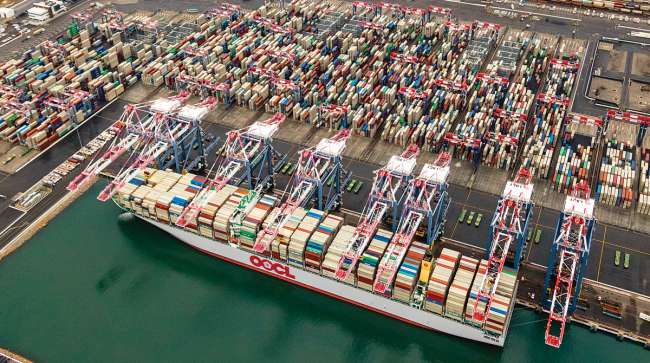The Port of Long Beach said container volume for the month increased 13.4% year over year to 765,385 units from 674,723. (Port of Long Beach)
U.S. ports continued to experience overall increases in container volume year over year in February.
The Port of Los Angeles processed 801,398 20-foot equivalent units, a 2.5% increase from the 781,434 containers in 2024. This marked the second-busiest February on record for the port, with container volume for the first two months increasing 5.4% to 1,725,643. The latest results mean that 17 of the last 19 months experienced year-over-year cargo growth for the port.
“That’s a testament to the outstanding work of the women and men of the International Longshore and Warehouse Union, our terminal operators, truckers, railroads and other stakeholders,” Port of Los Angeles Executive Director Gene Seroka said during a media briefing. “Many retailers and manufacturers have been importing their products through Los Angeles earlier than usual as a hedge against tariffs.”
Seroka warned there could be a 10% volume decline in the second half of the year given the substantial inventories and uncertainty around tariffs. But he also noted the port will continue to look for new opportunities to attract more businesses.
The Port of Long Beach said container volume for the month increased 13.4% year over year to 765,385 units from 674,723. The latest results marked the ninth consecutive month of volume gains as retailers continued to move goods ahead of anticipated tariffs placed on some imported goods. Container volume for the first two months increased 27.4% to 1,718,118.
“Our dockworkers, marine terminal operators and all of our industry partners are processing an extraordinary amount of cargo through this vital trans-Pacific gateway,” Long Beach Harbor Commission President Bonnie Lowenthal said. “We will continue to rely on our reputation of moving cargo quickly, reliably and sustainably while providing outstanding customer service.”
The Port of Oakland was delayed by a month with recent results showing cargo volume for January. For that month the port posted a 7% increase to 193,175 containers from 180,487. These results were driven by growth in both imports and exports.

Brandes
“Export volumes remain steady, highlighting the continued global demand for U.S. agricultural and manufactured goods,” Port of Oakland Maritime Director Bryan Brandes said. “This growth is a testament to the hard work and collaboration of our labor force, terminal operators and supply chain partners.”
Georgia Ports Authority reported its busiest February on record. The port noted that container volume increased 6% to 479,850 TEUs from 451,670. Its intermodal team is reporting record performance for rail and truck gate operations. The port, along with others on the East and Gulf Coasts, also will benefit from the newly secured labor contract with its workers through 2030.

Lynch
“This strong performance is a testament to the trust our customers place in the Port of Savannah as their gateway to the U.S. Southeast,” said GPA President Griff Lynch. “I would also like to congratulate the International Longshoremen’s Association and the U.S. Maritime Alliance on signing a six-year contract in February, which will ensure labor stability and support the prosperity of our state and nation.”
South Carolina Ports Authority reported that volume increased 11% to 225,532 TEUs from 202,349. The port attributed the growth largely to an influx of imports after more tempered monthly container volume. President Barbara Melvin also pointed to the state itself being the fifth in the nation for population and gross domestic product.
“This will continue to drive imports and exports to our port,” Melvin said. “The Southeast is booming, and we are ready to support this growing market with 10 million TEUs of capacity on the horizon and an expanded intermodal network.”
Port Authority of New York and New Jersey usually runs one month behind the other ports in releasing its numbers. In January, it experienced a 7.9% increase year over year in container volume to 720,283 TEUs from 667,346.
The Port of Baltimore and Port Houston did not have monthly numbers available at press time.






